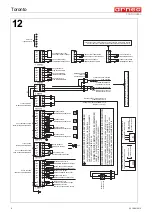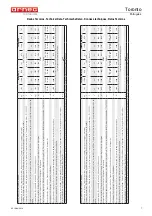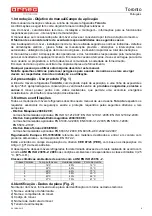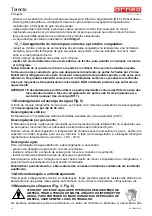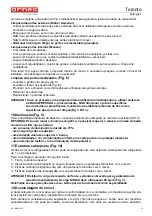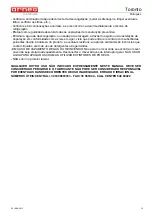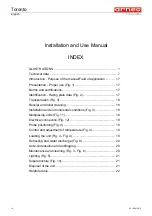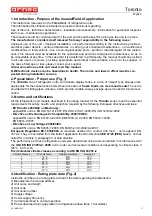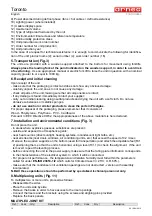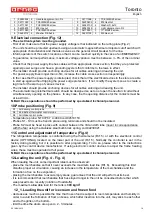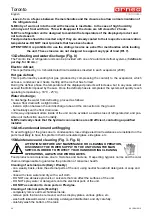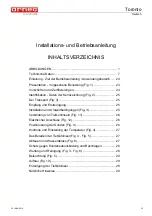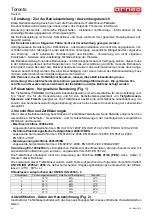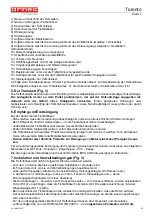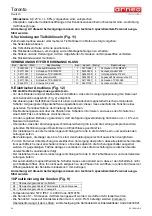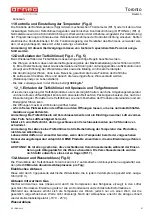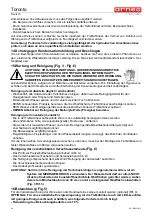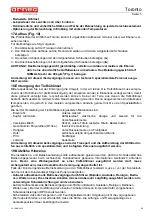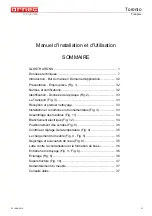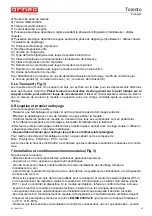
Toronto
English
20
00 18/04/2012
PORTUGUESA
- leave 4-5 cm. of space between the merchandise and the closures to allow normal circulation of
the refrigerated air.
N.B.Entry of warm air into the unit with closures is inevitable. In the case of high humidity,
a thin layer of frost will form. This will disappear if the doors are left closed for 2 hours.
N.B.The refrigeration unit is designed to maintain the temperature of the displayed product and
not to decrease it.
Food products should be inserted only if they are already cooled to their respective conservation
temperatures. DO NOT insert products that have been heated.
ATTENTION!: It is prohibited to use the sliding closures as a shelf for merchandise while loading
the unit. These closures are not designed to support any type of load (Rif. 7).
13.Defrosting and water discharge (Fig. 8)
The Toronto line of refrigerator units can be provided with one of 2 automatic defrost systems (
3 defrosts
per day, for 30 mn.
):
Electric defrost;
This is performed by no. 3 shielded electrical resistances inserted in each evaporator (230V).
Hot gas defrost;
This is performed by sending hot gas (produced by compressing the coolant) to the evaporator, which
acts as a condenser as it heats, melting all the ice that has formed.
During the defrost phase, the temperature of the displayed products will increase, but in any case will not
exceed the limits imposed by the Law. Once the defrost phase is completed, the system will quickly reach
operating temperature (- 18°C - 25°C).
Water discharge;
To discharge the water from defrosting, proceed as follows:
- have a floor drain with a slight incline.
- install a siphon between the unit discharge tube and the connection on the ground.
- hermetically seal the floor drain area.
In this way, unpleasant odors inside of the unit can be avoided, as well as loss of refrigerated air, and pos-
sible unit malfunction due to humidity.
N.B.Periodically check that the hydraulic connections are still efficient, contacting a qualified
installer.
14.Anti-condensation and antifogging
To avoid fogging of the glass due to condensation, low-voltage electrical resistances are installed on the
parts most likely to have this problem: thermo-insulated glass, side glass, etc.
15.Maintenance and cleaning (Fig. 3 - Fig. 6)
Food products can deteriorate due to microbes and bacteria. Respecting hygienic norms and the cold-
chain is indispensable to guarantee the protection of consumer health.
Cleaning of external parts (Daily / Weekly)
- on a weekly basis, clean the external parts of the unit, using neutral household detergents or soap and
water.
- rinse with clean water and dry with a soft cloth.
- DO NOT use abrasive products or solvents that can affect the surfaces of the unit.
- DO NOT spray water or detergents onto the electrical parts of the unit.
- DO NOT use alcohol to clean parts in Plexiglas.
Cleaning of internal parts (Monthly)
- completely remove all merchandise inside.
- remove parts that can be removed, such as display plates, various grilles, etc.
- wash with lukewarm water containing a detergent/disinfectant, and dry carefully.
- carefully wash the bottom of the tank.
ATTENTION!: BEFORE ANY MAINTENANCE OR CLEANING OPERATION,
DISCONNECT THE POWER SUPPLY TO THE UNIT USING THE MAIN
SWITCH. IN ORDER TO PROTECT YOUR HANDS DURING CLEANING
OPERATIONS, ALWAYS USE WORK GLOVES.
Содержание Toronto Series
Страница 4: ...Toronto 4 05060106 01 27 08 2015 10 1 2 3 4 a b ...
Страница 5: ...Toronto 05060106 01 27 08 2015 5 11 1 1 1 A B A CON LUCE WITH LIGHT ...
Страница 63: ...Toronto 4 00 18 04 2012 PORTUGUESA 10 1 2 3 4 a b ...
Страница 64: ...Toronto 00 18 04 2012 5 PORTUGUESA 11 1 1 1 A B A CON LUCE WITH LIGHT ...

